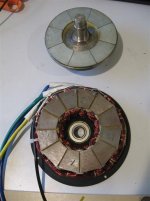boostjuice
10 kW
So as far as I can tell, Goldenmotor have at some point in time revised the stator design for their HPM5000B Axial Flux motor (and possibly also for the HPM10000B).
ES member 'Gestalt' posted internal photos of this motor's stator/rotor in November 2009 showing 8 magnets and 24 teeth.
Opening up my motor which has a build date of I think around early 2012 it can be seen that my version has the same 8 magnets but....... 12 teeth.
Can anyone shed some thoughts on:
A: Why Goldenmotor changed the design?
My potential list of suspicions include; reduced end turn losses, less winding labour/cost, increased optimisation of copper/iron ratio, lower required PWM current limiting frequency required to control the motor at full mechanical speed (6000rpm) using their proprietry range of controllers?
B: What relative effect this might have on the motor's behaviour considering that copper fill may or may not be the same (ie. rule of thumb effect on max torque vs continuous torque)
C: Which version of the motor might actually reflect the dyno chart/ dyno plot on Goldenmotor's website?
24 slot

12 slot

ES member 'Gestalt' posted internal photos of this motor's stator/rotor in November 2009 showing 8 magnets and 24 teeth.
Opening up my motor which has a build date of I think around early 2012 it can be seen that my version has the same 8 magnets but....... 12 teeth.
Can anyone shed some thoughts on:
A: Why Goldenmotor changed the design?
My potential list of suspicions include; reduced end turn losses, less winding labour/cost, increased optimisation of copper/iron ratio, lower required PWM current limiting frequency required to control the motor at full mechanical speed (6000rpm) using their proprietry range of controllers?
B: What relative effect this might have on the motor's behaviour considering that copper fill may or may not be the same (ie. rule of thumb effect on max torque vs continuous torque)
C: Which version of the motor might actually reflect the dyno chart/ dyno plot on Goldenmotor's website?
24 slot

12 slot


